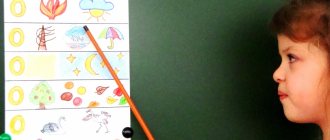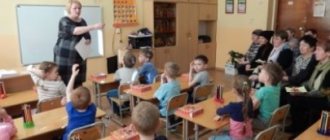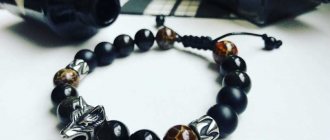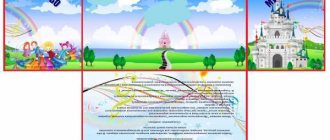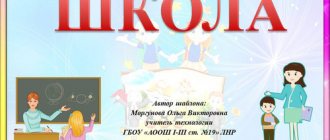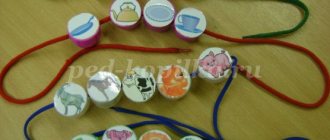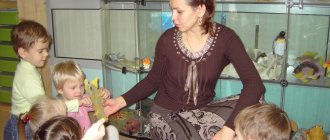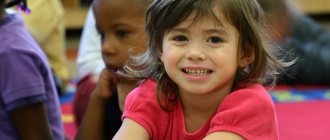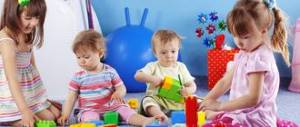Organization of a construction corner in kindergarten in accordance with Federal State Educational Standards
The main goals of organizing and operating a corner in a preschool educational institution (DOU):
- to arouse in pupils a desire to engage in constructive modeling activities;
- stimulate creativity and freedom of expression in the design process;
- Let the kids try themselves in different types of this exciting activity and choose the one they like best.
To do this, the construction corner must be equipped with all the materials provided for by the program, and also meet the requirements imposed by the Federal State Educational Standard (FSES) for the areas of the subject development environment of the kindergarten.
The design corner equipment should awaken children's interest in creative play.
General requirements for organizing a construction corner
In order for design and modeling classes in the corner to bring only joy and benefit to students, it is necessary to take into account the following points when organizing it:
- Safety. The main task of the preschool institution as a whole is to strengthen the health of pupils. Therefore, the developing environment must be completely safe for children. At a younger age, it is necessary to pay attention to the size of the construction parts: small ones that may pose a potential threat to health are not used at all, giving preference to elements with a side of 4–5 cm or more.
- In addition, each new construction set, both plastic and wooden, must be examined by the teacher, because parts may have manufacturing defects: burrs, chips, and the like. Low-quality sets of building materials should be exchanged with the seller, but minor defects, for example, molding residues on plastic parts, can be removed yourself and the surface can be sanded. The same applies to waste material for crafts: it is also carefully inspected, cleaned, and prepared for use by children.
- In the middle group, construction from natural materials is introduced. For independent creativity, children are offered materials that do not pose a danger: cones, walnuts, chestnuts, leaves, maple wings. Children make crafts using small materials (acorns, shells, bean seeds, sunflower seeds, etc.), as well as twigs, sticks, and pine needles under the supervision of a teacher. Control is also necessary in the older group, when children make crafts using wire, screws, and nuts.
When playing with a small construction set, the teacher should not leave even older children unattended.
- Children in the middle and older groups are given a conversation about the rules for using natural materials and small construction parts, teaching them to manage their behavior and take care of their own health, which will be very useful to them at school.
- .For artistic design (from paper, natural material), a table is equipped on which blanks and materials are laid out, leaving space for children to sit comfortably at it.
The plastic container is very convenient for storing construction set parts: children can pick it up and put it in place on their own
- The construction set for younger children contains cubes, bricks, prisms, cylinders and small plates; in the middle group they are supplemented with narrow plates of different lengths, square, rectangular for the construction of bridges and multi-story buildings. The parts in these construction sets are applied and superimposed on each other without being fastened, and playing with them involves simple actions (let's drive the car into the garage, put the dog in the kennel, put the baby doll in the crib).
- At a young age, a variety of shapes and colors is necessary as children develop sensory concepts (involving all the senses). In addition, younger preschoolers examine all objects, comparing their weight, what they feel like, and how they sound when they hit one another. The building material of plastic and wood gives them a lot of scope for research activity.
- At least once every six months, it is necessary to replenish the corner with new types of construction sets, natural materials, funny toys for playing with buildings, as well as drawings and photographs of various buildings, paper crafts and natural materials, so that children’s interest in this type of activity does not fade, but increases and gave impetus to learning new things.
The older the preschoolers, the more complex the structure they can build and the more vividly they will play with it.
In the design corner for older preschoolers, you can use photos and drawings depicting buildings, monuments, and architectural decorations they know in their hometown or village. This deepens children’s knowledge about their native land, encourages them to inherit, reproduce what they see, and fosters love for their small homeland, teaching them to see beauty nearby.
Construction in kindergarten
| According to the terms | In the process of such construction, children develop the ability to analyze conditions and, on the basis of this analysis, build practical activities of a rather complex structure. Children just as easily and firmly learn the dependence of the structure of a structure on its practical purpose and in the future can themselves - based on the establishment of such a dependence - determine the specific conditions to which their construction will correspond, create interesting ideas and implement them |
| By design | Creating a plan for a future design and its implementation is a rather difficult task for preschoolers: their plans are unstable and often change in the process of activity. It is necessary to develop the desire to build according to your own plans, combine buildings according to the plot, play with them, encourage them to play together |
| On this topic | Children are offered a general design theme (“Birds”, “City”, etc.), and they themselves create plans for specific buildings, crafts, choose the material and methods of their implementation |
Tasks in teaching and guiding children's constructive activities
:
To develop in children the necessary skills and design skills.
To give children knowledge about objects displayed in constructive activities, about their appearance, structure, main parts, shape, spatial arrangement, relative size, about the materials with which they work.
Children should be able to group objects according to their common characteristics and understand the relationship between the features of their shape and the functions they perform.
Determine the texture of paper (whatman paper, glossy color, writing), know thin cardboard, wire in an insulating winding, etc. Know their properties and possibilities of use. Children should be able to use paste, stationery and wood glue when gluing various materials.
Teach children to work purposefully and pre-plan their activities, which is a necessary condition for the successful completion of constructive tasks.
To foster in children independence in work and creative initiative.
To develop the ability to control one’s activities, to direct it towards a more rational path to solving the problem proposed by the teacher. To teach to understand that the purpose of design classes is not so much a practical result as the acquisition of new knowledge and skills, that is, to develop in children the ability to learn and readiness to study at school.
It is also necessary to use the rich opportunities for constructive activities to instill in children a sense of teamwork at work.
Basic techniques for teaching design
Features of the design corner equipment depending on the age of the children
At each age, preschoolers have their own psychophysiological characteristics, which should be taken into account when arranging and designing the construction and modeling area. By following a few simple tips, the teacher will make the construction corner in his group interesting and useful for kids:
- Fill the corner with materials in accordance with the program requirements for this type of activity in different groups. In the third year of life, this is a construction made from building material.
- In the fourth year of children’s lives (the second youngest group), construction (regular, slotted construction sets) and artistic (paper) construction are carried out.
- In the middle group, design from natural materials is introduced, as well as modeling of household items, furniture, and clothing from paper.
- In the senior group, the acquired skills are improved and consolidated; in addition, design is introduced without explanation or showing a sample, but only according to a drawing, diagram, or a series of sequential images.
- Children of younger groups are unfamiliar with Dunno, Chipollino, Samodelkin, so the heroes of fairy tales for older preschool age should decorate the corners of older groups. In younger groups, images of children's favorites would be appropriate: a bunny, a bear, a fox. Images of children engaged in construction are interesting and understandable to little pupils. Younger preschoolers will perceive these characters as friends and want to imitate them.
- In younger groups, the design and modeling area can be called “Little Builders”, “Funny Cubes”. The teacher will be able to explain such names based on the children’s direct experience.
Images of children playing fit perfectly into the design of the construction corner.
- Waste material is very valuable for construction: it gives children an idea of the plasticity and variability of shapes, because such material is cheap, it can be crushed, deformed, changed at their discretion, and combined with others. For example, make dolls from inverted paper cups, draw a face and make a hairstyle from threads, and place them in a house made of cardboard boxes, where the furniture will be smaller boxes for food and juices. Girls enjoy using fans and handbags in the game, which they themselves constructed from plastic plates, and boys play with cars made from milk cartons and reels.
Designing with paper allows kids to experience the joy of creativity and feel like real masters.
Approximate contents of the construction corner in a group of children of the fourth year of life
The tasks of the teacher in the field of teaching children of the second junior group to design are:
- Strengthen the ability to use floor and tabletop construction sets and construct buildings according to a model.
- Learn to distinguish and name designer parts and use them in construction, select parts by size and color.
- Develop children's independence by encouraging changes and additions to buildings (replacing parts, adding and adding to them), and encouraging design according to plan.
- Learn to play with structures, combine them into a single plot, use additional materials and toys.
- Continue to teach children how to design from paper, using the techniques of “crumpling”, “tearing”, “twisting”, complementing crafts or creating collective compositions: “Horse with a long mane”, “Fluffy kittens”, “Snowflakes are falling on a house”, “Apples on apple tree”, “Chickens in the meadow”.
- To introduce paper of various densities and textures, to arouse a desire to study its properties, to explore.
- To develop organization, neatness, and the ability to take care of building materials and put them away after playing.
To ensure the completion of these tasks, the following is placed in the design corner:
- Large floor constructor.
- A set of cubes, plates, bricks, cylinders for constructing buildings on tables in containers and boxes.
- Slotted Lego-type construction set (large or medium size).
- Dienesh blocks, Cuisenaire sticks, sets of geometric shapes of different colors for planar design.
- Small toys for playing out buildings and organizing story games (dolls, animal figurines, vehicles).
- Paper of different textures, densities, thicknesses: Whatman paper; cardboard; writing; corrugated. It can be in the form of rectangular and square sheets, or in the shape of a circle, basket, or tree. Children place details (apples, plums, balls, etc.) on this dense base.
An excellent addition to the corner in the younger group would be large mosaics, puzzles, cut-out pictures - that is, games in which you need to put parts together into a whole.
A bright mosaic with large details will teach kids how to construct images on a plane.
Equipment for a zone of constructive-model activity in the middle group
In the middle group, construction from natural materials is introduced. In addition, children’s ability to master new skills and abilities increases, memory and attention become more perfect. Therefore, the tasks of working with children of this age are expanding. The main tasks of the teacher are:
- Teach children to notice the variety of buildings, structures, transport during walks, excursions, stimulate the desire to reflect what they see in design.
- Improve knowledge of the names and properties of parts depending on the shape: a cube is more stable; a brick placed on a small edge may fall. Learn to use each part in accordance with its characteristics.
- Learn to analyze a building sample and determine what materials are needed to reproduce it.
- Encourage creative transformation of buildings, decoration using improvised means, encourage the successful selection of colors, details, and the manifestation of creative and non-standard thinking in the use of waste materials.
- Improve the ability to organize plot construction: playing the construction of a specific object with a division of roles.
- Learn to create simple designs from paper by folding a rectangle in half and a square diagonally, decorating them with the proposed ready-made shapes or ornaments, and adding details at your own request.
- Arouse interest and desire to make crafts from natural materials, using plasticine to attach parts, teach to see similarities in natural materials with objects and objects of the surrounding world, develop attention and ingenuity.
- Cultivate a caring attitude towards equipment, an understanding of one’s own role in maintaining order, and responsibility.
To make it interesting for children in the middle group to put away the construction set after playing, you can invite them to turn into drivers and use large cars to deliver all the parts to their places
Taking this into account, the design corner is replenished with the following materials:
- Thematic construction sets “City”, “Zoo”, “Children’s Playground” or similar ones.
- A set of small toys, including exotic animals, images of people of different ages (passers-by, children playing, traffic controller). Since it is not very easy to select such figures, and they are expensive, you can find them on the Internet and print out double-sided images of the characters, laminate them with film for strength and attach a corrugated cardboard stand. Such figures will enliven the game and make children want to come up with new situations and stories.
- Waste material, small (disposable plates and cups, spools, tea and food boxes) and large (shoe boxes, boxes of candy and cookies). Children make crafts from small materials, and use large ones to create and play out buildings like a ship, an airplane, or a city for dolls. For a more aesthetic appearance, large boxes are covered with leftover wallpaper and colored paper.
- Sets for paper making: rectangles and squares of different colors, details for decoration. Children can make their own postcard as a gift to their relatives, decorating it with a bouquet, an ornament of figures, an image of a fairy-tale hero, choosing from the variety of decor they like.
- All kinds of natural materials: chestnuts, cones, dry leaves, bark, branches, nut shells.
- Waste material: spools, juice boxes, disposable tableware.
- Plasticine for attaching craft parts, glue.
- Simple diagrams, drawings of crafts and buildings, images of buildings for various purposes (residential building, theater, kindergarten, clinic).
In the construction corner for the middle group, images of simple buildings are placed
Design corner for older preschoolers
Children of the sixth and seventh year of life have the most developed skills and abilities in handling various types of construction sets, paper and natural materials. The tasks of a teacher in working with children of this age are expanded as much as possible. Teaching older preschoolers how to design is aimed at:
- Forming an interest in buildings for various purposes, the ability to notice the features of their design, understanding how it is related to the functions of the building.
- Development of skills to analyze a building, its image, encourage independent construction of structures based on what they see.
- Formation of the ability to build according to a drawing, diagram, to make models of transport (airplane, locomotive, car) without a sample, according to a drawing or verbal instructions, from memory (disassembled and assembled).
- Development of creativity, imagination, independence in choosing a design theme: a fairy-tale city, the homes of fairies, robots, favorite characters, a fantasy ship, a pirate raft, etc.
- Fostering camaraderie, collectivism, the ability to take others into account and express one’s point of view, consult, and come to a common opinion.
- Consolidating already known methods of designing from paper and learning new things: rolling into a cone, cylinder, learning to create crafts based on a paper cone and cylinder.
- Development of creative imagination, creative thinking, the ability to freely transform shape, connect products to form plot compositions, encourage initiative and independence in choosing colors, designing crafts, adding details to them (additional drawing, gluing).
- Fostering a love for nature, the ability to appreciate its gifts, to see and cherish the beauty around you, as well as that created with your own hands.
In the older group, children not only build buildings, but turn their creation into a role-playing game, so they need additional toys and materials
The design corner in the senior groups of preschool educational institutions is the most diverse and richly equipped, since it adds to the previous types of designers:
- Metal with fastenings with nuts and screws. Plastic with fastening brackets. Wooden, in which the parts are fastened with pins. Small Lego constructors with a thematic focus, for example, “Doll house (with furniture)”, “Cafe”, “Hospital”, “Airport”, “Station”, “Castle”, “Kindergarten”.
- In addition, in the corner there should certainly be diagrams, drawings and photographs of buildings, city and rural landscapes, and perhaps even photographs of the locality where the children live.
- We should not forget about the availability of a supply of paper of different textures and shapes, natural and waste materials, toys for playing with or flat images of characters, vehicles, trees, flower beds, fences.
The creative approach of the teacher will help the kids populate the constructed city with paper characters. and then preschoolers themselves will want to draw the inhabitants of their magical town
Design center in the preparatory group.
Subject development environment. Design Center.
Our group has a design center.
Goal:
Consolidate the ability to design according to patterns , develop the ability to observe, analyze, compare and contrast objects according to characteristics, develop children’s creative abilities in free play activities .
Tasks:
1. To develop in children a sustainable interest in constructive activities , a desire to experiment, create, invent, and develop the ability to independently analyze structures and designs from the point of view of the practical purpose of objects;
2.Exercise in construction according to conditions, topics, and plans. Learn how to use ready-made drawings and make your own changes to designs ;
3. Teach how to widely use a variety of constructors .
Relevance:
Formation of the personality of a preschooler is an extremely complex and multifaceted process.
It involves many driving forces, factors, and mechanisms. Construction has a great influence on the development of the child’s personality and volitional sphere. So, its effectiveness is influenced by the nature of the motive: why the building is needed. Success depends on the ability to hold the goal of an activity and set it independently, on the ability to control the progress of work, and compare the result obtained with a model. In the process of construction, the physical improvement of the child is carried out. Constant exercise in a wide variety of movements, accompanied by an emotional upsurge, contributes to the fact that these movements become fast, dexterous, and easily subject to the control of the eye. The coordinated work of individual muscles improves. Constructive activity is an effective means of aesthetic education. When children are introduced to buildings and structures (residential buildings, buildings of kindergartens, schools, etc.), as well as architectural monuments that are accessible to their understanding, they develop an artistic taste that causes aesthetic pleasure when looking at beautiful structures, and the ability to appreciate what has been created is formed. creative work of people, to love the architectural riches of their city, country, to take care of them. In addition, preschool children develop an understanding of the appropriateness of architectural solutions. Various types of construction sets have been collected:
“Stars”, “Molecules”, “Smart Sticks”, “Dixtik”, wooden, magnetic and metal construction sets, “3 D ”, and others.
Folder for origami and paper construction : Various types of paper and cardboard, scissors, glue and more.
Toys for playing with buildings : small cars, animals, dolls, trees and more.
Natural and waste materials for construction:
beans, peas, cones, shells, pebbles, corks, matches, braid, fabric, buttons and more.
A methodological collection has been prepared , which includes diagrams for all types of construction sets, GCD notes, didactic games, and consultations for parents.
Design corner passport
Since construction equipment is very diverse, but requires constant replenishment and updating, it is necessary to maintain a passport for the corner. It will indicate all available materials, basic and auxiliary, types of construction sets, educational games, etc. This will help the teacher to control the situation, to know what needs to be changed, supplemented, and for colleagues and young teachers to become familiar with all the contents of the corner and learn from the teacher’s experience.
Table: an approximate example of a passport for a mathematical corner in a preschool educational institution
| Chapter | Section Contents |
| Heads of the corner | Teacher or group teachers, education, category |
| Placement | Group, preschool educational institution |
| The purpose and objectives of the corner | Goals and objectives are indicated, for example: To promote children's interest in design and modeling, the development of logical thinking, memory, attention, creativity, fostering a sense of friendship, collectivism, independence, and careful attitude to the equipment of the corner. |
| Explanatory note | The relevance of creating a corner, the main types of activities in it, and the expected results of the work are indicated. |
| Construction designers | Separately, ordinary (indicating the material from which they are made) and thematic (indicating themes) are listed. |
| Technical constructors (for modeling) | The name of the designer, material, type of fastening (pin, screws) are indicated. |
| Paper construction materials | List of materials. |
| Natural material | List of materials. |
| Waste material | List of materials. |
| Auxiliary materials | List (plasticine, glue, wire, elements for decorating crafts). |
| Didactic educational games | List of games, possibly a brief description. |
| Visual aids, literature | List of literature and manuals (folders, albums with illustrations, posters, diagrams, photos). |
| Notes | If desired, the teacher can supplement the passport with notes on various types of activities in the corner, as well as a plan for the work of the corner for six months or a year (topics and tasks of joint activities with children). |
Photo gallery: samples of design of zones of constructive-model activity
The modeling area in the senior group contains thematic construction sets for both boys and girls
The construction corner in the senior group is very decorated with bright boxes for building materials
This constructive activity area features a comfortable table and magnetic board for displaying diagrams
If the size of the group room allows, a separate rack can be allocated for construction from natural materials
In the construction corner for little builders there may also be soft toys - favorites for which children will build housing.
A paper construction corner can be a wonderful decoration for a group.
Origami operation cards for older preschool children
Valentina Nazarova
Origami operation cards for older preschool children
As a teacher working with children with SLI, I was interested in the possibility of using the origami to develop speech during organized activities. It is known that speech without sensory experience is not possible. Origami allows the child to “feel”
and
“feel”
with your fingers.
In addition, the availability of paper as a material, the ease of its processing (the ability to maintain the shape given to it)
- all this attracts
children , and the opportunity to “transform”
a simple piece of paper is of great interest.
Therefore, by developing the child’s hand and fingers, we activate the development of the speech zone. Today, no one doubts the fact that the more agile a child’s fingers, the more developed his speech. To make it interesting and accessible for children to create crafts using the origami . I made operation cards . Which I bring to your attention.
Goal: to teach children the basic shape of the “circle”
make a bullfinch head;
learn to bend the corners of a craft, rounding the workpiece; an operational map in work ; develop eye and fine motor skills.
Goal: to teach children the basic triangle
make a
“bear”
using
the “fold”
,
“lightning”
and
“mountain”
;
add expressiveness using appliqué; use the operation card ; develop spatial orientation, develop fine motor skills.
Goal: to teach children the basic triangle
make a
“dog”
by bending sharp corners and bending the lower and upper two corners;
teach children to make a torso from the basic “kite”
;
use an operational map .
Goal: to teach children the basic triangle
make a
“little fox”
by bending sharp corners, add expressiveness
(eyes, nose)
Introduction to
the operation chart ; improving skills in working with paper and scissors
Goal: to teach children the basic triangle
make a
“bunny”
by bending the corners to the intended line and bending the bottom strip upward, using
a step-by-step map ; increase children's in making crafts using the origami ; develop the eye. fine motor skills
Goal: to teach children the basic triangle
make a
“wolf”
by bending the lower corner, adding expressiveness with the help of appliqué;
use the operation card ; develop spatial orientation, develop fine motor skills.
Goal: to teach children the basic triangle
make a
“mouse”
“zipper”
and
“valley”
fold techniques , bending the corners and sides towards the center line;
use the operation card
Analysis of the design of a construction corner in a preschool educational institution
An analysis of the design and content of the corner is carried out by a methodologist or senior teacher of a preschool institution during a thematic inspection of the condition of the constructive-model activity zones of all groups. Self-analysis can be carried out by the group teacher in order to outline a plan for further work to update and replenish the materials and equipment of the corner.
When analyzing, the following main points are taken into account:
- Compliance with safety rules when organizing a corner and selecting equipment.
- Age appropriate for the children in the group.
- Accessibility, functionality, practicality (the ability to use equipment and materials in class, in games, whether children can pick it up and put it back in place).
- Developmental focus of the zone: does it give children the opportunity to organize story games with buildings, learn new things, broaden their horizons (especially important in older groups).
- Do the corner equipment include: different types of construction sets, modeling kits; toys for playing out buildings, images of role-playing characters (passers-by, policeman, cafe worker, hospital worker, etc.), animal figurines, toy vehicles of various sizes; material for construction from paper, natural, waste and auxiliary materials (plasticine, glue, wire, small elements for decoration).
- Does it promote the development of creativity and imagination (the presence of children's crafts, drawings, educational literature, manuals).
- Aesthetics, originality and creativity of design.
The results of the analysis are discussed at the teachers' council; round tables, seminars, and pedagogical workshops can be devoted to constructive-model activities, where educators exchange ideas, creative findings, and best practices.
Unfortunately, not all kindergarten groups yet have separate construction zones where pupils could fully demonstrate their talents and engage in exciting and useful construction-model activities. However, organizing such a corner is not a difficult task; on the contrary, it is fascinating and necessary. Having set the goal of creating such a corner, filling it with rich and varied material, the teacher will find the support of colleagues and parents of students, and the best reward for his work will be the joy and creative discoveries of little masters - the children of the group.
Regulations on the inspection of design centers in preschool educational institutions
Approved by the Head of the Medical Educational Institution No. ____ ___________/______________
Pedagogical council No. 1 dated 24.08. 2020
Regulations on the “Design Centers” show
in MADOU No.___________ for the 2017-2018 academic year
Target:
Creating conditions in preschool educational institutions for the development of cognitive, research and productive (constructive) activities and artistic and creative abilities of children.
Objectives of the review:
- Replenish and update the supply of design centers.
- To contribute to improving the level of equipment of the developing subject-spatial environment of preschool educational institutions.
- To promote the development of the creative potential of preschool teachers.
- To improve the professional skills of teachers on the development of design skills in preschoolers.
- Help strengthen the connection between the preschool educational institution and the family.
Participants of the review:
Teachers and parents of all kindergarten groups, qualified specialists, and a senior teacher take part in the review.
commission
:
- _______________
- _______________
- _______________
- _______________
- _______________
Organization and procedure for the review:
The review is held on March 12-13, 2018.
Criteria for evaluation:
0—no criterion; 0.5 - partially present; 1-present in full. The maximum number of points is 5.
The results of the review of design centers are taken into account in teacher activity cards when distributing incentive payments.
| No. | Review indicators in groups (for teachers) | Taken into account | Maximum points |
| 1 | Creating conditions for organizing constructive activities in the group | 1 | |
| 1.1 | Age appropriate content | ||
| 1.2 | Openness and accessibility for children | ||
| 1.3 | Storage of children's works (ladder, shelf, rack) | ||
| 2 | Variety of materials | 1 | |
| 2.1 | Sets of cubes 4-12 pcs (younger age); floor building material; desktop building material (plastic construction sets: younger age - with large parts, older age - with small parts); construction sets with metal parts - older age; thematic sets (“City”, “Train”, etc.) - middle age; soft constructors on a carpet base - younger age. | ||
| 2.2 | Schemes, samples of buildings in drawings, drawings, etc.; photographs, albums with illustrations of cities, bridges, transport, houses, furniture, etc. | ||
| 2.3 | A box with accessories for construction (figures of people, animals, small cars, boats, airplanes, etc.) | ||
| 2.4 | Materials for construction from paper, natural materials, waste materials. | ||
| 3 | Compliance with health and safety requirements of equipment and materials | 1 | |
| 3.1 | Safety of equipment and materials | ||
| 3.2 | Compliance with hygiene requirements | ||
| 3.3 | Compliance with aesthetic requirements | ||
| 3.4 | Rational placement | ||
| 4 | Identifying initiative and a creative approach to creating conditions for children’s constructive activities | 1 | |
| 5 | Promoting the relationship between the preschool educational institution and the family | 1 | |
| 5.1 | Parents' participation in replenishing equipment and materials for children's constructive activities | ||
| 5.2 | Availability of visual information for parents on constructive modeling activities | ||
| Total points | 5 | ||
| No. | Review indicators for the methodological room (senior teacher, teacher of additional education in fine arts) | Taken into account | Maximum points |
| 1 | Creating conditions for organizing constructive activities in preschool educational institutions | 1 | |
| Availability of methodological manuals on the topic, systematization | |||
| 2 | A variety of materials for constructive activities in the teaching room | 1 | |
| 2.1 | Sets of building materials of different types | ||
| 2.2 | Materials for design, light construction | ||
| 2.3 | Schemes, samples of buildings in drawings, drawings, etc.; photographs, albums with illustrations of cities, bridges, transport, houses, furniture, etc. | ||
| 3 | Compliance with health and safety requirements of equipment and materials | 1 | |
| 3.1 | Safety of equipment and materials | ||
| 3.2 | Compliance with hygiene requirements | ||
| 3.3 | Compliance with aesthetic requirements | ||
| 3.4 | Rational placement | ||
| 4 | Identification of initiative and creative approach to creating conditions for constructive activities of children in preschool educational institutions | 1 | |
| 5 | Promoting the relationship between the preschool educational institution and the family | 1 | |
| Availability of visual information for parents on constructive modeling activities | |||
| Total points | 5 | ||
| No. | Review indicators for qualified specialists | Taken into account | Maximum points |
| 1 | Creating conditions for organizing constructive activities in the classroom | 1 | |
| Availability of teaching materials with design elements | |||
| 2 | Availability of construction materials in offices | 1 | |
| Sets of materials for design, diagrams, samples, albums with illustrations | |||
| 3 | Compliance with health and safety requirements of equipment and materials | 1 | |
| 3.1 | Safety of equipment and materials | ||
| 3.2 | Compliance with hygiene requirements | ||
| 3.3 | Compliance with aesthetic requirements | ||
| 3.4 | Rational placement | ||
| 4 | Identifying initiative and a creative approach to creating conditions for children’s constructive activities | 1 | |
| 5 | Promoting the relationship between the preschool educational institution and the family | 1 | |
| Availability of visual information for parents on constructive modeling activities | |||
| Total points | 5 | ||
